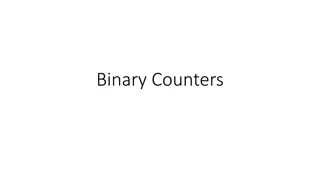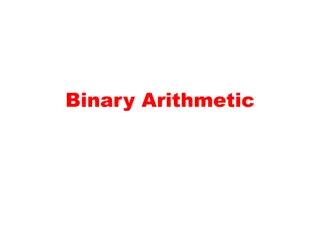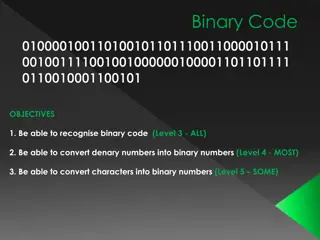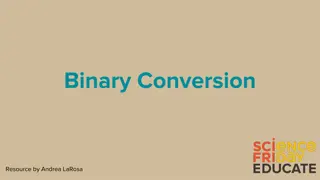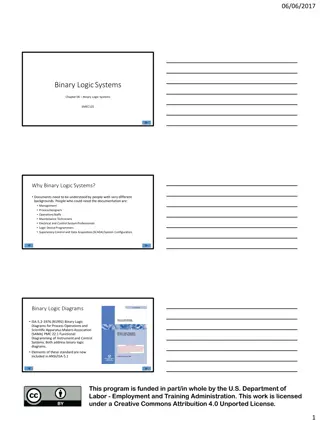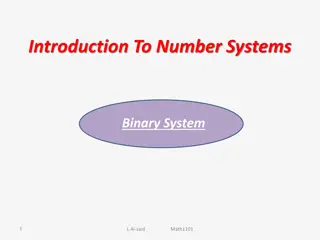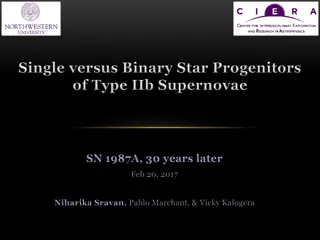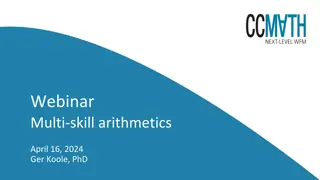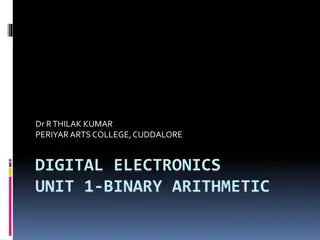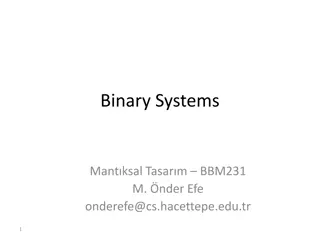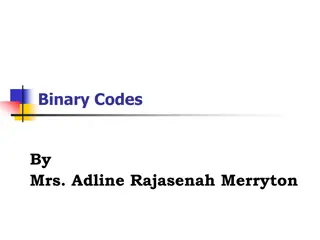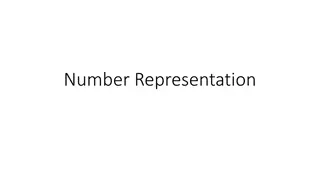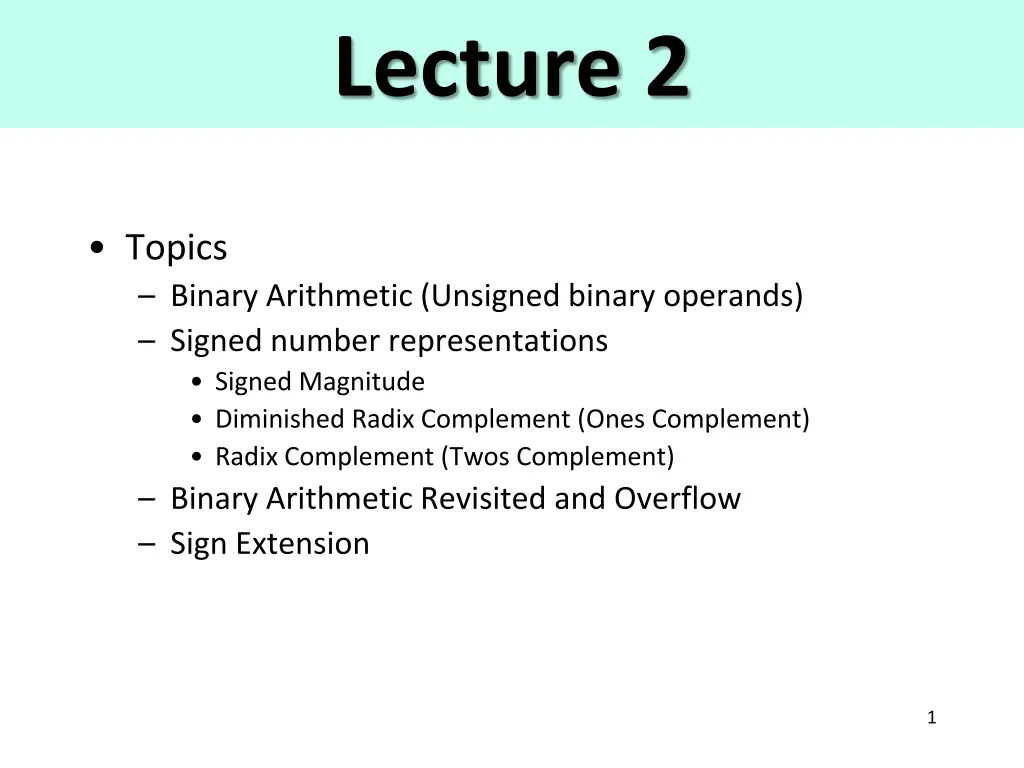
Binary Arithmetic and Number Representations
Learn about binary arithmetic, signed number representations (including signed magnitude, diminished radix complement, and radix complement), overflow, and different binary addition methods. Understand the concepts with examples and illustrations for a comprehensive understanding of the topic.
Download Presentation

Please find below an Image/Link to download the presentation.
The content on the website is provided AS IS for your information and personal use only. It may not be sold, licensed, or shared on other websites without obtaining consent from the author. If you encounter any issues during the download, it is possible that the publisher has removed the file from their server.
You are allowed to download the files provided on this website for personal or commercial use, subject to the condition that they are used lawfully. All files are the property of their respective owners.
The content on the website is provided AS IS for your information and personal use only. It may not be sold, licensed, or shared on other websites without obtaining consent from the author.
E N D
Presentation Transcript
Lecture 2 Topics Binary Arithmetic (Unsigned binary operands) Signed number representations Signed Magnitude Diminished Radix Complement (Ones Complement) Radix Complement (Twos Complement) Binary Arithmetic Revisited and Overflow Sign Extension 1
Binary Arithmetic Rules for carry same as in decimal Here are the rules for adding of each bit carry 1 0 0 0 0 1 1 1 0 1 1 + + + + 1 10 carry 2
Unsigned Binary (UB) Addition Examples (4-bit word) 2 + 6 11 + 6 1 1 1 1 1 11 0010 0110 1000 2 1011 0110 10001 Overflow + 6 17 + + 6 8 + 17 > 24-1 3
Overflow (Underflow) Definition: Result of an arithmetic operation is too large (or small) to be represented in number of bits available Detection: Varies with the representation. For unsigned binary, it s determined by a carry out of the MSB 1 1 1 1 1 10101101 01101100 100011001 8 bit operands + 4
Signed Numbers Have been assuming non-negative numbers Unsigned Binary (UB) Several representations for signed numbers Sign Magnitude (SM) Diminished Radix Complement (DRC) 1s Complement Radix Complement (RC) 2s Complement 5
Sign Magnitude MSB functions as sign bit 0 = positive 1 = negative Range of numbers: -(2n-1 1) to +(2n-1 1) n = 6 Two representations for 0 Negative formed by complementing sign bit 1510 = 001111SM -1510 = 101111SM 010100SM = 2010 110100SM = -2010 6
Diminished Radix Complement (DRC) Called Ones Complement MSB indicates sign 0 = positive 1 = negative (but not a sign bit!) Range of numbers: -(2n-1 1) to +(2n-1 1) Two representations for 0 Negative formed by complementing entire word (called taking the ones complement ) 1510 = 001111DRC -1510 = 110000DRC 010100DRC = 2010 101011DRC = -2010 7
Radix Complement (RC) Called Twos Complement MSB indicates sign 0 = positive 1 = negative (but not a sign bit) Range of numbers: -(2n-1) to +(2n-1 1) Only one representation for 0 Negative formed by complementing entire word and adding 1 (called taking the twos complement ) 1510 = 001111RC -1510 = 110001RC 010100RC = 2010 101100RC = -2010 8
Radix Complement (RC) Called Twos Complement MSB indicates sign 0 = positive 1 = negative (but not a sign bit) Range of numbers: -(2n-1) to +(2n-1 1) Only one representation for 0 Negative formed by complementing entire word and adding 1 (called taking the twos complement ) 1510 = 001111RC -1510 = 110001RC -3 1 1 1 1 0 1 000011 =3 111100 = neg 111101=-3 010100RC = 2010 101100RC = -2010 9
Twos Complement Special Cases
Twos Complement Special Cases Example: Take Twos Complement (RC) of 0000 (010) 0000 1 1 1 Only one representation for 0 1111 + 1 0000 Complement Add One Ignore carry out of MSB 11 Note: Discard carry out of sign bit position!
Twos Complement Special Cases Example: Take Twos Complement (RC) of 1000 (-810) (most negative) -810 1000 1 1 1 +810 is not represented 0111 + 1 1000 Complement Add One Can t represent Complement of the most negative number 1000 (-810) is the most negative number 12
Why do we use RC (Twos Complement)? Only one representation for zero Simplified Addition in Twos Complement! Sign Magnitude Addition has complicated algorithm below: Must consider two operands without sign bits If sign bits same: perform add, check overflow If sign bits different: subtract (two cases) +A and B A B A and + B B A Generate correct sign bit for sum Radix Complement (Twos Complement) Addition Just add! Simple Subtraction Done via addition A + B A B = A + (-B) Caution: Can t take negative of most negative number BCD (which we ll see shortly) was used in very early 4-bit microprocessors, but 2s complement is universally used now 13
Conversions of Signed Representations
Conversions of Signed Representations From Decimal Conversion from decimal Represent the absolute value of the number in unsigned binary (UB) Use the correct number of bits (add leading 0s) If the decimal number is negative, use the appropriate rule to negate the representation Sing/Magnitude (S/M) complement the sign bit DRC (ones complement) complement every bit RC (twos complement) complement every bit, add 1
Conversions of Signed Representations to Decimal Conversion to decimal if number is + convert from unsigned binary to decimal (done!) Conversion to decimal if number is - 1. use appropriate rule to negate it (obtain its absolute value) Sign/Magnitude complement the sign bit Ones complement complement every bit Twos complement complement every bit, add 1 2. Convert this (positive) number as though unsigned binary to decimal 3. Add a negative sign 16
Binary Arithmetic Unsigned Binary (UB) Signed Binary (SB) Diminished Radix Complement (DRC) 1s complement Radix Complement (RC) 2s complement Rarely used 17
Radix Complement (RC) or Twos Complement Addition Subtraction and Negative Numbers Examples (4-bit word) 7 + (-2) 5 + (-7) 1 1 1 1 0101 1001 1110 5 0111 1110 10101 7 + (-7) (-2) + + + (-2) 5 No overflow Ignore carry out of MSB 18
Radix Complement (RC) or Twos Complement Addition Examples (4-bit word) -7 + (-2) We added two negative numbers and got a positive result! Overflow!! 1 1001 1110 10111 -7 + + (-2) -9 -9 < - (23) Ignore carry out of MSB 19
Carry and Overflow
Carry and Overflow Is this an overflow condition? 1 1 1 0 1 1 0 0 10101101 01101100 100011001 + If this is an unsigned binary (UB) number Yes! Overflow in UB 21
Carry and Overflow Is this an overflow condition? 1 1 1 0 1 1 0 0 10101101 01101100 100011001 + If this is a radix complement (RC) number No! A negative number plus a positive number cannot produce an overflow No overflow in Twos Complement 22
Carry and Overflow Radix Complement (2s Complement) Consider: Positive + Negative Never overflow Negative + Negative Overflow possible Positive + Positive Overflow possible Detecting Overflow: If signs of addends are same and sign of sum is different Equivalent to CSBP CSBP+1 C Carry SBP Sign Bit Position 23
Carry and Overflow in Twos Complement CSBP= CSBP+1 CSBP+1 CSBP C Carry SBP Sign Bit Position 1 1 1 0 1 1 0 0 10101101 01101100 100011001 + No overflow in Twos Complement A negative number plus a positive number cannot produce an overflow 24
Addition in Twos Complement Examples (4-bit word) CSBP+1 CSBP -7 + (-2) CSBP We added two negative numbers and got a positive result! CSBP+1 1 0 0 0 1001 1110 10111 -7 + + (-2) -9 Overflow! -9 < - (23) Conclusion on Overflow in 2s Complement: There is an overflow if signs of addends are same and sign of sum is different Equivalent to CSBP CSBP+1 In this case there is an overflow 25
Sign Extension What happens when you move a number from a smaller word size to a larger one? UB S/M RC (2s complement) 00000011 (3) 00000011 (3) 00000011 (3) 0000000000000011 (3) 0000000000000011 (3) 0000000000000011 (3) bad (253) (-125) (-3) 11111101 11111101 11111101 (253) (-125) (+253!) 0000000011111101 1000000001111101 0000000011111101 Unsigned Binary is no problem, fill with zeros Sign Magnitude is no problem, sign goes to MSB (-3) 11111101 good (-3) 1111111111111101 extend the sign bit left through the new MSB 26
Subtraction in Two s - Complement
Addition versus Subtraction Use same technique as decimal Except that the addition and subtraction tables are different Already seen addition table Truth table for Sum and Cout function
Subtraction table difference bin 0 0 0 0 1 1 1 1 x 0 0 1 1 0 0 1 1 y 0 1 0 1 0 1 0 1 bout 0 1 0 0 1 1 0 1 d 0 1 1 0 1 0 0 1
Another method of doing subtraction borrow out borrow difference
Examples of decimal and corresponding binary subtractions
A modular counting representation of 4-bit two s-complement numbers There is no plus 8
A modular counting representation of 4-bit unsigned numbers
Summary of addition and subtraction rules for binary numbers
Questions, Problems and EXAM Problems 1. Meaning of carry bit. 2. Addition of unsigned numbers 3. Addition in two s-complement system 4. Addition in ones-complement system. 5. Subtraction of unsigned numbers 6. Subtraction in two s-complement system 7. Subtraction in ones-complement system. 8. Advantages of sign-magnitude system. 9. Advantages of two s-complement system 10.Advantages of ones-complement system 35
Questions and problems Questions, Problems and EXAM Problems 11. Discuss examples to add binary numbers in Two s-complement code (representation) and when it leads to overflow? 12. What are the advantages of Two s-complement code? 13. Discuss overflow in Two s-complement code. 14. Discuss subtraction overflow in Two s- complement code. 15. Discuss advantages and disadvantages of number systems. 16. Discuss sign extension and show examples. 36
Sources Prof. Mark G. Faust John Wakerly


